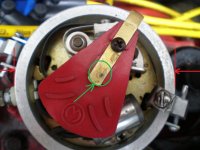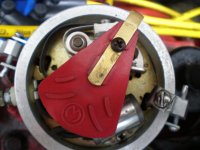Peter, the distributor cap carbon button should be centered over the distributor shaft.
From the looks of your rotor, it is off a tad (see green circle), but remains centered rotationally.
If this is an older Mallory, it may require the smaller diameter cap..... perhaps the "flat" cap!
If the larger cap is installed (and I've never done this) it may be resting off center.... which may increase the gap between the rotor tip and cap contacts on one side.
Check the OD dimension (between the red arrows) against your cap ID dimension.
 Points:
Points:
Are you setting point "dwell", or relying on "gap"?
Gap is an estimate ONLY of correct dwell.
You'll need to set your contacts points using a dwell meter for best results.
Timing:
Set BASE advance, but you must also see where the Ignition TA or TAT is (total advance timing).
Without the correct TA, the engine will not perform as expected or hoped for.
See your OEM specs for this.
If you need help with the TA procedure, post back.
Hi Ricado
- Just a note, all 8 cylinders are performing at around 105 to 110psi.
- What I will do is check my compression meter to make absolutely sure it is reading right.
- Is it possible that the inlet valves are coked up, not closing properly hense low cylinder pressure?
Peter
Your Comp readings are close enough together for this alone to be a good sign. Let's hope that your gauge is off a tad. Are you using the correct compression testing procedure?
Yes, it is possible, however, your readings are very close to one another!
As for a "wet" test, there is a caveat to this for a V-8 engine.
First, you may have the full dished pistons..... of which means that a tremendous amount of oil will be required to reach the ring landings in a radial fashion.
The more oil added, the more volume the oil consumes, and the greater the cylinder pressure is increased.
But to what amount does this alone increase cylinder pressure as aposed to actually temporarly sealing the rings?????
Secondly, this is a V engine..... gravity plays against us when we attempt to wet the ring landings.... meaning that it pulls any oil to the low side of the ring landings,
preventing an equal and radial wetting of the rings.
I could add 18cc of oil to a cylinder and show you a pressure increase from the oil volume alone.
Point being........ it's not always a reliable method to determine if piston rings are bad/good for a V engine.
I'd rather see you do a cold/warm compression test, and compare readings.
Perhaps follow that with a cylinder leak-down test.
.



